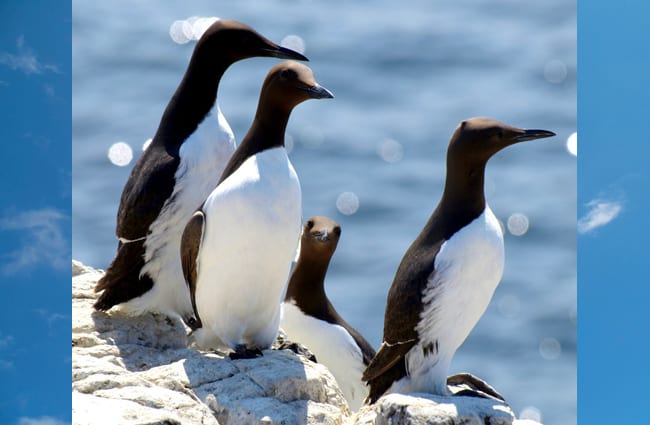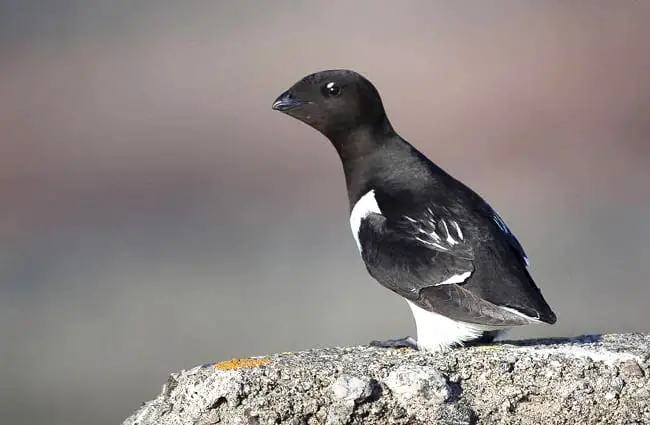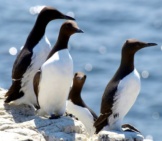Auks are seabirds that look somewhat like penguins, but they can fly. There is an entire taxonomic family that people often refer to as “auks,” the Alcidae family. There are many different birds in the Alcidae family, including puffins, auklets, and murres, but there are only two species of “true” auks.
The two true auk species alive today are the lesser auk and the little auk, both of which will be the focus of this article. Read on to learn about the auk.
Description of the Auk
Both species of auks are somewhat similar in appearance, but they are different genetically and in body structure. They both have black heads, wings, backs, and tails, with white chests and bellies. Much like penguins, this coloration gives them a tuxedo-like appearance.
Lesser auks have large, thick beaks, and a two-foot-long wingspan. Little auks are smaller, with a wingspan of about one foot, and they have shorter beaks.
Interesting Facts About the Auk
While they might look like penguins, auks are a different bird entirely. They have a number of unique traits and behaviors, learn more below!
- Missing Member – While there are only two living species of auks nowadays, there was once a third species, the great auk. This species went extinct in 1844, primarily due to hunting. While they lived, these birds were much larger than their cousins, standing nearly three feet tall!
- Colonial Living – Both species of auks congregate in large groups, known as colonies, to breed. They choose steep cliffs near the sea, and build their nests on ledges. Nesting on cliffs is a relatively common occurrence for seabirds, because cliffs are difficult for predators to climb.
- Not Quite Safe – Even though they choose treacherous nesting sites, that doesn’t mean they are completely safe from predators. A number of different predators still manage to feed on auks, their eggs, and their chicks. Some predators include polar bears, gulls, ravens, crows, and falcons.
- Dedicated Parents – Auk parents do their best to protect their chicks and their mates. Both parents are dutiful caregivers. The male and the female share the duties of incubation and feeding. The same birds return and build nests together every year for life.
Habitat of the Auk
Both species of auks live in and above the ocean. Like many seabirds, they only return to land when they reproduce. They choose seaside cliffs to create their nests.
Large colonies of auks congregate on these cliffs and nest together for safety. After rearing their chicks, the birds return to sea until the next year’s breeding season.
Distribution of the Auk
Auks live in the northern Atlantic Ocean, but their exact distribution varies by species. Lesser auks live and nest off the coast of North America, primarily the east coast of Canada and the northeast United States.
Their range also extends to Greenland and across to Europe. Little auks live off the coast of the northeast United States and Canada as well, but their range into Europe is smaller.
Diet of the Auk
Like most seabirds, auks feed primarily on fish and marine organisms. Schooling fish are the easiest to find, because they congregate in large numbers that are visible above the surface.
The smaller little auk eats shrimp and copepods more than fish. The larger lesser auk feeds mostly on fish, but also eats squid, shrimp, and other crustaceans.
Auk and Human Interaction
Just like their cousin, the extinct great auk, humans hunt little and lesser auks for eggs, meat, and feathers. Habitat destruction and global climate change also impact their ability to survive. Breeding colonies are particularly susceptible to habitat destruction, oil spills, and hunting.
Because they nest in such large numbers, when humans damage or hunt these colonies entire populations are decimated. The IUCN lists the little auk as Least Concern, and the lesser auk as Near Threatened.
Domestication
Humans have not domesticated auks in any way.
Does the Auk Make a Good Pet
No, auks do not make good pets. I may have mentioned it before, but I’ll repeat it again, animals that eat fish generally have very smelly poop. That means, of course, that they usually make poor pets. Also, it is illegal in most places to own an auk as a pet.
Auk Care
Because they spend most of their life at sea, it is obviously incredibly important for this species to have access to water. The more water the better! Many zoos also implement artificial rocks and cliffs for these birds to nest on.
In zoos, these birds often live with puffins and penguins, because they live in similar climates. Zookeepers feed them a variety of small fish, krill, squid, and other crustaceans.
Behavior of the Auk
Though these birds breed in massive colonies, they usually hunt alone. Large groups depart to fish at the same time, and sometimes feed in the same area, but they usually spread out and hunt alone. These birds do not cooperate while hunting in any way.
Once they reach sexual maturity, auks court potential mates. Once they have chosen a mate, they continue to breed with the same auk for life.
Reproduction of the Auk
Once they arrive at the breeding colony, the pair of birds chooses a cliff ledge to build their nest. They find a cave, crevice, or a nice indented spot, and fill it with pebbles, shells, and feathers.
The female lays a single egg, and both parents incubate it. The egg hatches after incubating for about a month. Both parents feed the chick, and after about a month it will begin to fly and go fishing with its parents.











![Red Angus Closeup of a beautiful Red Angus cowPhoto by: U.S. Department of Agriculture [pubic domain]https://creativecommons.org/licenses/by/2.0/](https://animals.net/wp-content/uploads/2020/03/Red-Angus-4-238x178.jpg)


![Red Angus Closeup of a beautiful Red Angus cowPhoto by: U.S. Department of Agriculture [pubic domain]https://creativecommons.org/licenses/by/2.0/](https://animals.net/wp-content/uploads/2020/03/Red-Angus-4-100x75.jpg)

